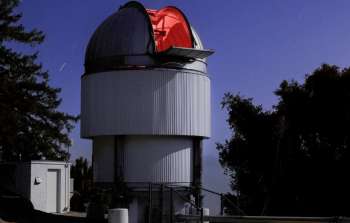sci22085 — Announcement
The CHARA Array Marks Decadal Milestones
September 19, 2022
By G. Schaefer (CHARA, GSU) and S. Ridgway (NSF’s NOIRLab)
In 2001 when the Georgia State University Center for High Angular Resolution Astronomy (CHARA) Array was dedicated, its 300-meter telescope baselines provided the highest optical resolution available to astronomers. Now 20 years later, with the same telescopes and baselines, this is still true. During that time, almost everything else has changed. Succeeding generations of beam combiners extend the performance in sensitivity, in spectral coverage and in imaging power. Major recent or in-progress developments include higher-performance visible and infrared beam combiners, and adaptive optics on all telescopes. Programs in preparation include the addition of a movable telescope with optical fiber link to the fixed array, and continuing design work on possible future array upgrades to larger apertures.
In 2010 CHARA first offered array access to the general community, making time available through the NOAO TAC twice per year. GSU absorbed the associated costs, taking the lead in developing the science community of interferometer users. Starting at about 10 nights per year, that allocation has increased. Thanks to NSF grant support through the MSIP program, CHARA now offers up to 50 nights per year for open competition. The records show that during the decade theNOIRLab/NOAO TACs have processed 276 proposals representing 340 distinct participating observers [PI + coI].
The open-access proposals span a broad range of science goals. One main focus is measuring the angular diameters of stars across the H-R diagram, including massive stars, low-mass M-stars, and exoplanet hosts. These measurements provide precise stellar radii when combined with GAIA distances. Multiplicity surveys conducted on different types of stars have yielded companion detections with separations between 0.5 to 100 mas and contrasts up to 200 times fainter. Several programs are mapping the orbits of binary stars, providing precise dynamical masses of Cepheids, Wolf-Rayet stars, and stars in nearby clusters. These results are helping to refine mass-luminosity relations and the ages of clusters. Imaging projects are investigating the evolution of starspots on magnetically active stars, convection cells on supergiant stars, and mass transfer in binary systems. A target-of-opportunity program has observed recent nova outbursts to monitor the expansion of the ejecta and the development of asymmetries over time. There has also been an observation of an active galactic nuclei.
The next generation of instrumentation at the CHARA Array offers improved sensitivity and more options for combining all six telescopes across multiple wavelength regions. The recently commissioned MIRC-X and MYSTIC beam combiners feature low-read-noise detectors and provide six-beam combination simultaneously in the near-infrared H and K bands. The low-spectral-resolution mode provides sensitivity down to H = 7.5 mag. The main science drivers for MIRC-X and MYSTIC include imaging circumstellar disks around young stars to better understand planet formation and imaging stellar surfaces. A new, visible light, six-telescope combiner called SPICA has been installed at the CHARA Array and is being commissioned during the 2022B semester. The goal of the SPICA project is to provide a large and homogeneous set of stellar parameters across the H-R diagram. The survey aims to measure the angular diameters of 1000 stars. A higher-spectral-resolution mode will be available for spectral imaging of stellar surfaces and environments and kinematic studies of brighter stars. Development work has started on a new, near-infrared, three-beam combiner called SILMARIL that seeks to extend the sensitivity of the array down to 10th mag.
Open-access time at the CHARA Array is available through the NOIRLab time allocation process. CHARA staff provide assistance to new observers to help with planning observations and collecting data. Given the ongoing pandemic, all science observations are currently conducted remotely through a virtual machine that runs all the graphical user interfaces for the control software. The virtual machine runs a VNC server so it can be accessed from anywhere with an internet connection. Open access observers are encouraged to participate in the observations. Travel support is available when in-person observations resume. CHARA provides support for data reduction and calibration.
About the Announcement
| Id: |
ID
sci22085
|
